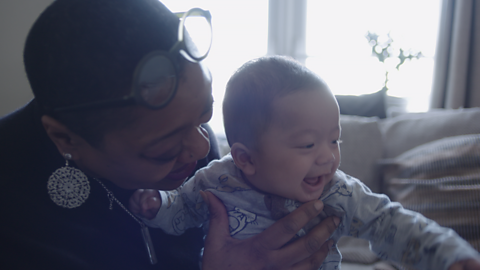Home > Tools for Talking > 4 months > 5 months > 6 months
They might be a while off talking, but even at 3-6 months your baby is starting to learn the back and forth patterns of conversations.
The best way to encourage them is to give them time to respond to you, listen out for the noises they make during play and react to them.
Find out why in the video below.
They might not be saying words yet, but do you know, babies learn the art of conversation by you responding to them.
And there's no better time to encourage chats with your baby than during play. They love games and they're learning when to take part.
So respond to your baby's noises straight away and they might respond back. They're starting to understand the sounds they make get a response and reacting to your sounds. All the right tools for talking.
And that's why it's never too early to have mini chats with your baby, so keep doing it!
What does serve and return mean?
Even early on in their language development, babies are able to listen out for what you're saying to them and respond with either noises or gestures.
If you leave gaps when talking to your baby, stop and wait, making eye contact, to see if they respond in some way. Then, you can respond again to the noises or movements they make - whether that's copying it back to them, repeating what you said, describing what they do - anything really.
Speech and language therapists often call this type of play 'serve and return', because you can think of this back and forth interaction as being a bit like a game of tennis - you serve them some chat and they return some noise or movements when it's their turn to respond.
How does serve and return play help babies learn?
Playing these games will show your baby that their noises are important and that you're listening and waiting for them. This will encourage your baby to make more sounds and eventually form words.
Serve and return games with babies
There are all sorts of back and forth games to play with your baby to practise serve and return chats.
Ready, steady, go games are a fantastic way to build anticipation and turn-taking skills with your baby. You could try it with all sorts of props like cups of water, bubble-blowing fluid or even ripping newspaper.
Peek-a-boo is not just a surefire way of making babies laugh, but it is also a great way to practise turn-taking and build their sense of object permanence (the idea that you don't disappear when you're out of sight).






